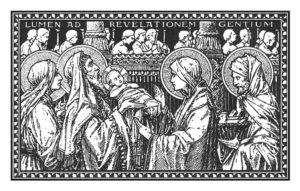 The Lord be with you
The Lord be with you
In a “conservative” Church, we like to pretend that things are unchanging. In reference to the big things, like Word and Sacrament, Law and Gospel, the Bible as the Word of God, the death and resurrection of Jesus as the central event of all time, things really do not change. But that doesn’t mean that nothing changes. New hymns are written all the time. New hymnals are published all the time. New liturgical colors can be introduced (like how we now use blue during Advent instead of purple). Names get changed, even names of days and dates on our liturgical calendar.
Some of these changes reach back in time, or across denominational lines. Some are just plain new. Introduce onto the pages of my “desk diary” (i.e. my calendar) are Latin names for various Sundays, including the four Sundays of Advent. (Latin names have been absent since 1982. That was when Lutheran Worship was introduced.) Those “new” Advent Sunday names are: Advent 1, called Ad Te Levani; Advent 2, called Populus Zion; Advent 3, called Gaudete; and Advent 4, called Rorate Coeli.
These are being called “sanctoral dates.” “Sanctoral” is a word that comes from the Latin word “sanctus” and means “holy.” The word “saint” comes from the same Latin word, so saints are, literally, “holy ones.” They are holy, of course, not because of anything they have done but because they have been made holy through the imputed righteousness of Christ.
In the Roman Catholic Church, the Sanctoral Cycle refers to the saints’ days they celebrate. However, as our calendar is calling Sunday’s with no specific saint being associated with it by Latin names, it seems we are using a broader understanding. Also, not every Sunday has received a Latin name. It seems to me that the Sunday’s that had Latin names back in the days of The Lutheran Hymnal have had Latin names restored. In those days, the Latin names were based on the Psalm of the Day. Some would say the Introit, but as the Introit was always based on the Psalm of the Day back then, it is really a disagreement about nothing. Both are correct.
As I look at the se names, they do seem to be based on one or the other of the appointed propers for the day, but not necessarily the Introit. Ad Te Levani (Advent 1) means “I lift up to You.” The second verse of the Introit is “To you, O Lord, I lift up my soul.” Populus Zion (Advent 2) means “the people of Zion.” The Gradual for that Sunday begins, “Rejoice greatly, O daughter of Zion.” Gaudete (Advent 3) means “we rejoice.” The Gradual for that Sunday begins with the words, “Rejoice greatly”. Rorate Coeli (Advent 4) means, “rain (or dew) from heaven.” The opening line from the Introit appointed for Advent 4 is “Shower, O heavens, from above, and let the clouds rain down righteousness.” So these names are probably the first line, in Latin, from these propers.
se names, they do seem to be based on one or the other of the appointed propers for the day, but not necessarily the Introit. Ad Te Levani (Advent 1) means “I lift up to You.” The second verse of the Introit is “To you, O Lord, I lift up my soul.” Populus Zion (Advent 2) means “the people of Zion.” The Gradual for that Sunday begins, “Rejoice greatly, O daughter of Zion.” Gaudete (Advent 3) means “we rejoice.” The Gradual for that Sunday begins with the words, “Rejoice greatly”. Rorate Coeli (Advent 4) means, “rain (or dew) from heaven.” The opening line from the Introit appointed for Advent 4 is “Shower, O heavens, from above, and let the clouds rain down righteousness.” So these names are probably the first line, in Latin, from these propers.
Why reintroduce Latin names for some Sundays? I have not seen any official, or even quasi-official, information about the reasoning. Some may feel such names are archaic and obscure, and not care of them. Others will feel they are a way to strengthen our connection to the entire Church of God, including those who have gone before us. In other words, they remind us that Christianity did not burst into existence in our life-time.
If this current modification helps some of us to think more deeply about the great acts of God, then I would support their use. After all, the very word “advent” is actually a Latin word that means “coming” and reminds us that Jesus came in time that first Christmas, that he has also come to us through the waters of Baptism and that he will come again to judge the living and the dead.
Advent (Coming) Blessings,
Pastor
